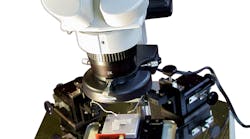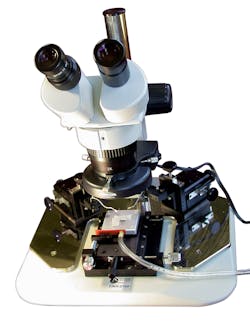Sampling An Array Of Test Probes And Fixtures
Test probes and fixtures for RF/microwave applications are as diverse as the components, devices, and materials they evaluate. These measurement “accessories” must inject and extract signals to and from a device under test (DUT) while remaining as close to electrically “invisible” as possible. Tracking current trends in RF/microwave test probes and fixtures is typically a matter of understanding the performance levels of the DUTs which they must handle. In turn, those performance levels are driven by the applications the DUTs serve, generally for higher power levels in smaller package sizes.
Last February, this magazine provided an “RF Essentials” article on probes and fixtures for RF/microwave testing, explaining some of the basic requirements for the different types of probes and fixtures for coaxial and on-wafer measurements. Probe and fixture products are available from a wide range of suppliers, including companies known for testing and those that are component suppliers (which may have developed probes and fixtures for their own requirements).
In sorting through the capabilities of any set of test probes and fixtures, it is also important to realize that calibration software is a vital complement to any probe or fixture. This minimizes electrical contributions to a test system that will typically include a signal source and an analyzer—such as an RF/microwave scalar network analyzer (SNA) or a vector network analyzer (VNA). Calibration techniques are generally known for the type of measurement standards they employ, including shorts and opens, Among the leading calibration techniques for fixtures, probes, and VNAs are the short, open, load, through (SOLT), line-reflect-match (LRM), and line-reflect-line (LRL) approaches.
1. The LMS-2709(S) Laboratory Microprobe Station is stable and repeatable enough to function effectively with microwave probes to 220 GHz. (Photo courtesy of Jmicro Technology.)
One of the best-known names in high-frequency test probes and fixtures, Cascade Microtech®, supplies a wide range of products—from probes and probe cards to full on-wafer probe systems. The company’s founders, Reed Gleason and Eric Strid, created the first microwave wafer probe in the early 1980s and have built a company around the high quality of their probes and probe systems; Cascade currently offers more than 50 different probe models for wafer, package, and board-level characterization. An essential requirement for any test probe system is its capability to move signals from the waveguide or coaxial environment of the test equipment to an electrical environment that may be much different for the DUT, including semiconductor wafers and miniature surface-mount packages.
As an example, Cascade’s Infinity Probe® line, which was introduced in 2002, is available with standard models operating to 220 GHz and special models available for on-wafer measurements to 500 GHz. The on-wafer devices they contact can have a variety of different arrangements for how signal (S) and ground (G) points are fabricated. Hence, the Infinity Probes incorporate membrane contact tips with different pitches (50 to 250 μm) and numerous ground and signal configurations, such as GSG, SG, GSGSG, and GSSG. The firm’s Waveguide Infinity Probe uses a membrane GSG contact tip to reduce stray electromagnetic (EM) fields near the probe tip for improved crosstalk performance between the probe tips and usable performance through 500 GHz.
Earlier this year, Cascade introduced its CM300 on-wafer measurement system, a scalable platform for device characterization and modeling. It works with test automation software to speed and improve the repeatability of on-wafer measurements, even when testing over wide temperature ranges. According to Debbora Ahlgren, Cascade’s Vice President of Marketing, “With the CM300, our customers benefit from highly configurable and scalable solutions. By allowing them to create more precise model parameters and achieve reliable, repeatable contact over temperature and time, the CM300 helps them achieve faster time-to-market on new devices and technologies.” The CM300 system can be used for high-volume measurements on devices with contact pads as small as 30 μm.
Jmicro Technology is another leading supplier of RF/microwave probes and probe stations, with the firm’s LMS-2709(S) Laboratory Microprobe Station serving industrial and academic customers for over five years. The compact test station (Fig. 1) is suitable for college and industrial laboratories for testing both active and passive components and devices with the aid of additional test equipment, such as test signal sources and vector network analyzers (VNAs). The standard vacuum chuck on the LMS-2709(S) can handle semiconductors, thick-film, and thin-film circuits as large as 2 x 2 in. (5.08 x 5.08 cm) with as much as 1 x 1 in. (2.54 x 2.54 cm) stage movement. Precision x-y-z positioning manipulators help align test probes to better than 0.0003 in. (0.01 mm) positioning accuracy. The LMS-2709(S) measures 12.5 x 12.5 in. (31.75 x 31.75 cm), is less than 20 in. (50.8 cm) high, and weighs about 32 lbs (14.51 kg).
SemiProbe LLC is yet another supplier of high-quality RF/microwave probe systems, with a patented adaptive architecture that promises to combat obsolescence. The company’s unique “Probe Systems For Life™” series of DC/RF/microwave wafer-probing systems, such as the PS4L probe station (Fig. 2), can be modified at any time to suit any application for testing packaged or on-wafer devices. A PS4L probe station can be purchased as a manual system and upgraded to a fully programmable probe station at any time, using different interchangeable function modules. It can even be equipped with different stages for evaluating wafers with diameters from 2 to 12 in. and features enough stability for use with test probes from DC through 220 GHz.
2. The “Probe Systems For Life™” line of probe stations use interchangeable function modules to quickly alter measurement capabilities. (Photo courtesy of SemiProbe LLC.)
Probe stations such as the PS4L require precision test probes from another supplier, like the Picoprobe® test probes from GGB Industries. These test probes are available in a wide range of frequencies, from active high-impedance models operating from DC to 500 MHz to microwave probes such as the model 40A with coverage of DC to 40 GHz using 2.92-mm coaxial K connectors. It is available with a number of tip materials, including nickel and tungsten, and contact pitches ranging from 50 to 2540 μ}m. GGB’s Picoprobes employ individually spring-loaded contacts to achieve better than -80-dB measurement repeatability with high return loss and low insertion loss.
Along with supporting RF/microwave probe systems and test fixtures, several companies are well known for their precision impedance tuners to assist with load-pull testing of different on-wafer and packages devices. Both Focus Microwaves and Maury Microwave offer a variety of precision tuners that can greatly benefit testing with a VNA and RF/microwave probe or test fixture, and both companies can provide test fixtures for a wide range of product package styles, including for MMICs and components in TO-packages.
When a high-frequency measurement involves a single device or circuit board for characterization, a suitable test fixture can provide an effective means of bringing test signals to and from the circuit under test. Inter-Continental Microwave has a long history of developing quality RF/microwave test fixtures for handling packaged transistors, diodes, ICs, and even passive components (such as capacitors). In addition to its extensive lines of standard test fixtures, the company offers fast turnaround time on fixtures designed and built according to a customer’s requirements.
Some of Inter-Continental Microwave’s fixtures, such as the model WK-7000 Universal Substrate Test Fixture, attempt to handle as many different DUTs as possible. Offering a frequency range of DC to 40 GHz, the WK-7000 is designed for use with microstrip substrates and to accommodate DUTs with many different physical parameters. It employs interchangeable transition assemblies for upgrading to higher frequency ranges as needed. Numerous versions are available, with built-in DC bias and for testing over wide temperature ranges.
Additional suppliers of RF/microwave test probes and fixtures include Altair Microwave, Inc., Electro-Photonics LLC, Keycom, MicroTest, NPS, Inc., Southern Microwave, Inc., and Wentworth Laboratories. Finally, some components suppliers, such as Synergy Microwave Corp., will often supply test fixtures for its products, including its various types of dielectric resonator oscillators (DROs) and voltage-controlled oscillators (VCOs).


